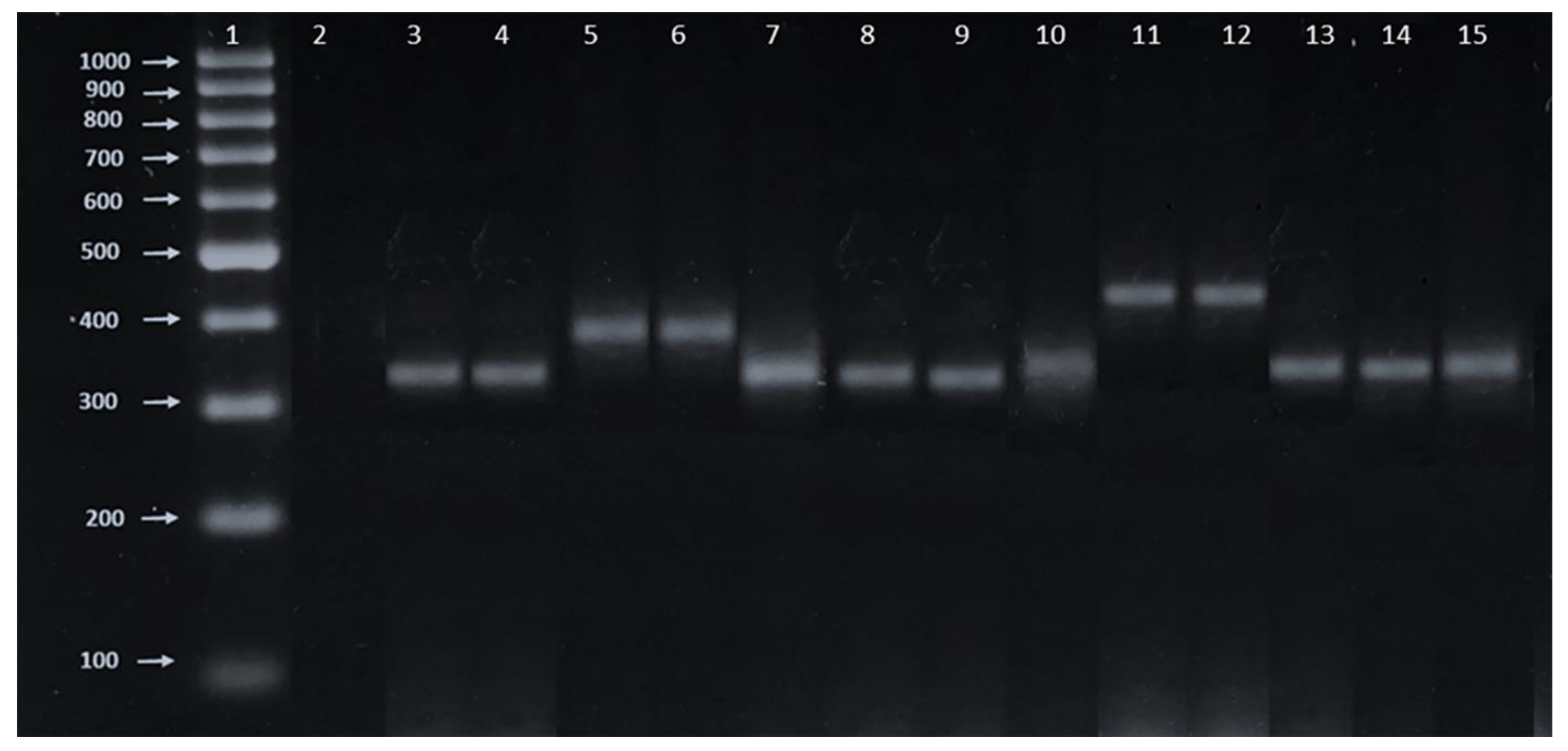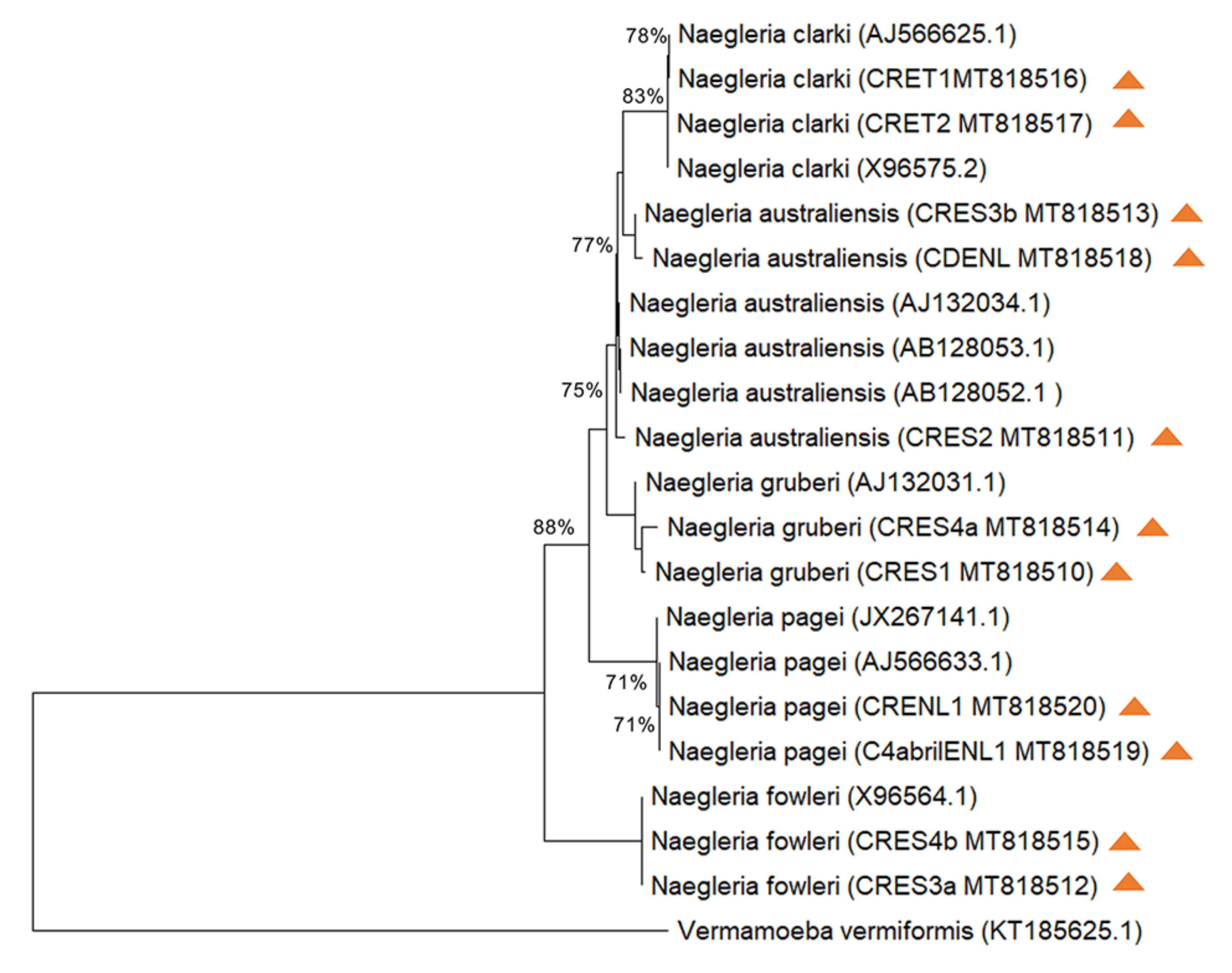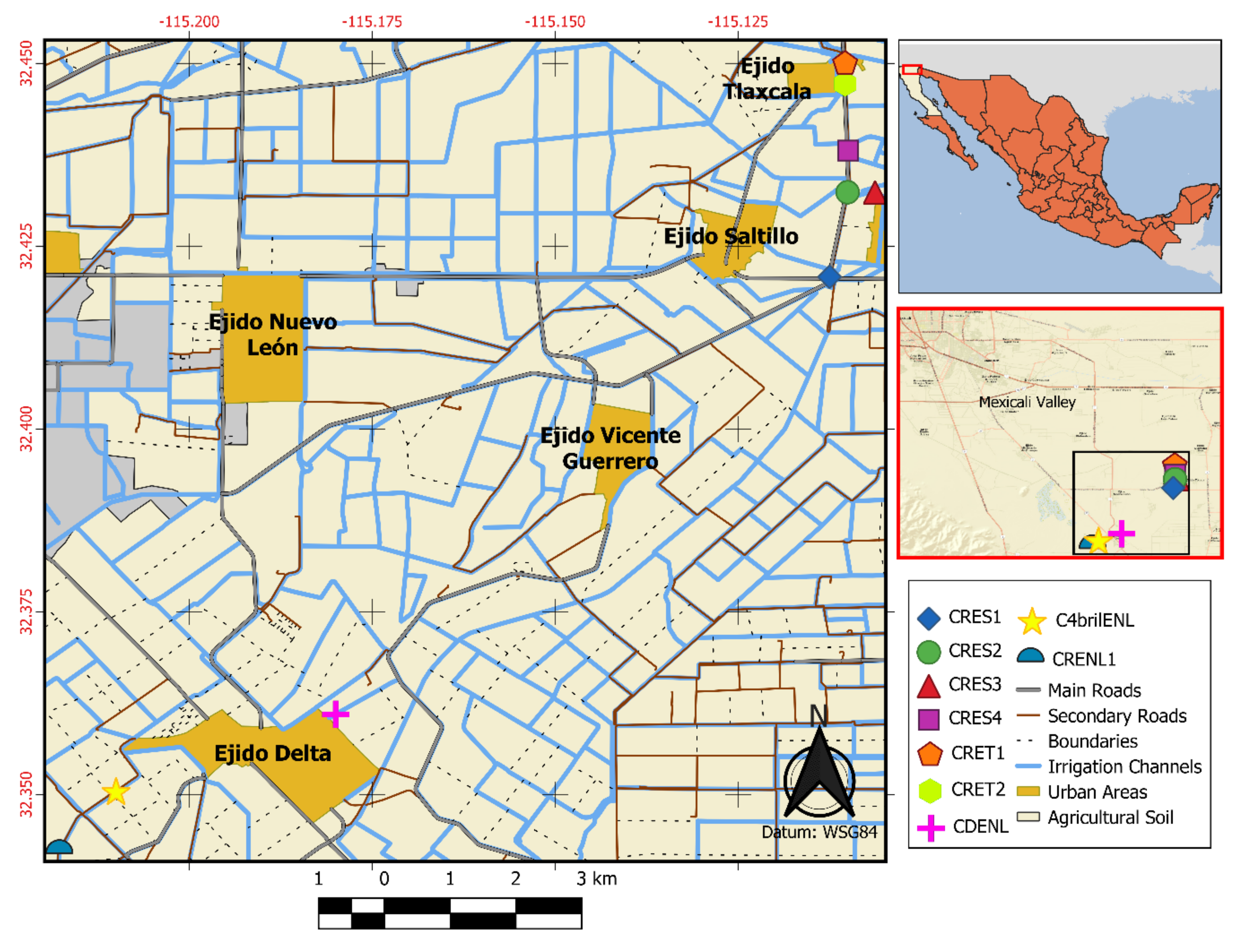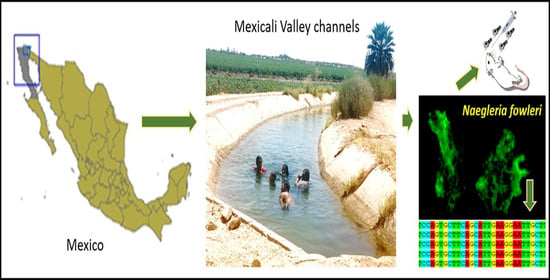Isolation and Identification of Naegleria Species in Irrigation Channels for Recreational Use in Mexicali Valley, Mexico
Abstract
:1. Introduction
2. Results
2.1. Physicochemical Parameters
2.2. Morphological Description of Naegleria
2.3. Pathogenicity Test
2.4. Molecular Characterization
2.5. Sequencing and Homology Analyses
2.6. Phylogenetic Tree
3. Discussion
4. Conclusions
5. Materials and Methods
5.1. Sampling
5.2. Processing Samples
5.3. Morphological Identification
5.4. Pathogenicity Test
5.5. DNA isolation and PCR
5.6. Sequencing and Phylogenetic Analysis
Author Contributions
Funding
Conflicts of Interest
References
- Siddiqui, R.; Ali, I.K.M.; Cope, J.R.; Khan, N.A. Biology and pathogenesis of Naegleria fowleri. Acta. Trop. 2016, 164, 375–394. [Google Scholar] [CrossRef]
- Visvesvara, G.S. Infections with free-living amebae. Handb. Clin. Neurol. 2013, 114, 153–168. [Google Scholar] [CrossRef] [PubMed]
- Visvesvara, G.S.; Moura, H.; Schuster, F.L. Pathogenic and opportunistic free-living amoebae: Acanthamoeba spp., Balamuthia mandrillaris, Naegleria fowleri, and Sappinia diploidea. Fems. Immunol. Med. Microbiol. 2007, 50, 1–26. [Google Scholar] [CrossRef] [Green Version]
- Gautam, P.L.; Sharma, S.; Puri, S.; Kumar, R.; Midha, V.; Bansal, R. A rare case of survival from primary amebic meningoencephalitis. Indian. J. Crit. Care. Med. 2012, 16, 34–36. [Google Scholar] [CrossRef] [PubMed] [Green Version]
- Yoder, J.S.; Eddy, B.A.; Visvesvara, G.S.; Capewell, L.; Beach, M.J. The epidemiology of primary amoebic meningoencephalitis in the USA, 1962–2008. Epidemiol. Infect. 2010, 138, 968–975. [Google Scholar] [CrossRef] [PubMed] [Green Version]
- Zhang, L.L.; Wu, M.; Hu, B.C.; Chen, H.L.; Pan, J.R.; Ruan, W.; Yao, L.N. Identification and molecular typing of Naegleria fowleri from a patient with primary amebic meningoencephalitis in China. Int. J. Infect. Dis. 2018, 72, 28–33. [Google Scholar] [CrossRef] [Green Version]
- De Jonckheere, J.F. Origin and evolution of the worldwide distributed pathogenic amoeboflagellate Naegleria fowleri. Infect. Genet. Evol. 2011, 11, 1520–1528. [Google Scholar] [CrossRef]
- Fowler, M.; Carter, R.F. Acute pyogenic meningitis probably due to Acanthamoeba sp.: A preliminary report. Br. Med. J. 1965, 2, 740–742. [Google Scholar] [CrossRef] [Green Version]
- Martinez-Castillo, M.; Cardenas-Zuniga, R.; Coronado-Velazquez, D.; Debnath, A.; Serrano-Luna, J.; Shibayama, M. Naegleria fowleri after 50 Years: Is it a neglected pathogen? J. Med. Microbiol. 2016. [Google Scholar] [CrossRef]
- Heggie, T.W. Swimming with death: Naegleria fowleri infections in recreational waters. Travel Med. Infect. Dis. 2010, 8, 201–206. [Google Scholar] [CrossRef]
- Krol-Turminska, K.; Olender, A. Human infections caused by free-living amoebae. Ann. Agric. Environ. Med. Aaem 2017, 24, 254–260. [Google Scholar] [CrossRef] [PubMed]
- Jahangeer, M.; Mahmood, Z.; Munir, N.; Waraich, U.E.; Tahir, I.M.; Akram, M.; Ali Shah, S.M.; Zulfqar, A.; Zainab, R. Naegleria fowleri: Sources of infection, pathophysiology, diagnosis, and management; A review. Clin. Exp. Pharm. Physiol 2020, 47, 199–212. [Google Scholar] [CrossRef] [PubMed] [Green Version]
- Valenzuela, G.; Lopez-Corella, E.; De Jonckheere, J.F. Primary amoebic meningoencephalitis in a young male from northwestern Mexico. Trans. R. Soc. Trop. Med. Hyg. 1984, 78, 558–559. [Google Scholar] [CrossRef]
- Cervantes-Sandoval, I.; de Serrano-Luna, J.J.; Tapia-Malagon, J.L.; Pacheco-Yepez, J.; Silva-Olivares, A.; Galindo-Gomez, S.; Tsutsumi, V.; Shibayama, M. Characterization of Naegleria fowleri strains isolated from human cases of primary amoebic meningoencephalitis in Mexico. Rev. Invest. Clin. 2007, 59, 342–347. [Google Scholar]
- Rodríguez, E.G. Meningoencefalitis por Naegleria fowleri, informe de un caso. Infectología 1984, 4, 263–266. [Google Scholar]
- Lopez-Corella, E.; De Leon, B.; de Jonckheere, J.F. Primary amebic meningoencephalitis caused by Naegleria fowleri in an adolescent from Huetamo, Michoacan, Mexico. Bol. Med. Hosp. Infant. Mex. 1989, 46, 619–622. [Google Scholar]
- Vargas-Zepeda, J.; Gomez-Alcala, A.V.; Vasquez-Morales, J.A.; Licea-Amaya, L.; De Jonckheere, J.F.; Lares-Villa, F. Successful treatment of Naegleria fowleri meningoencephalitis by using intravenous amphotericin B, fluconazole and rifampicin. Arch. Med. Res. 2005, 36, 83–86. [Google Scholar] [CrossRef]
- Matanock, A.; Mehal, J.M.; Liu, L.; Blau, D.M.; Cope, J.R. Estimation of Undiagnosed Naegleria fowleri Primary Amebic Meningoencephalitis, United States(1). Emerg. Infect. Dis. 2018, 24, 162–164. [Google Scholar] [CrossRef] [Green Version]
- Lares-Villa, F.; De Jonckheere, J.F.; De Moura, H.; Rechi-Iruretagoyena, A.; Ferreira-Guerrero, E.; Fernandez-Quintanilla, G.; Ruiz-Matus, C.; Visvesvara, G.S. Five cases of primary amebic meningoencephalitis in Mexicali, Mexico: Study of the isolates. J. Clin. Microbiol 1993, 31, 685–688. [Google Scholar] [CrossRef] [Green Version]
- Atlas de Riesgo del Municipio de Mexicali. Available online: www.mexicali.gob.mx/transparencia/administracion/atlas/pdf/0.pdf (accessed on 25 September 2020).
- Page, F.C. A New Key to Freshwater and Soil Gymnamoebae: With Instructions for Culture. Freshwater Biological Association: Cumbria, UK, 1988; p. 122. [Google Scholar]
- Dykova, I.; Kyselova, I.; Peckova, H.; Obornik, M.; Lukes, J. Identity of Naegleria strains isolated from organs of freshwater fishes. Dis. Aquat. Organ. 2001, 46, 115–121. [Google Scholar] [CrossRef]
- Sifuentes, L.Y.; Choate, B.L.; Gerba, C.P.; Bright, K.R. The occurrence of Naegleria fowleri in recreational waters in Arizona. J. Environ. Sci Health A Tox. Hazard. Subst. Environ. Eng. 2014, 49, 1322–1330. [Google Scholar] [CrossRef] [PubMed]
- Kyle, D.E.; Noblet, G.P. Seasonal distribution of thermotolerant free-living amoebae. I. Willard’s Pond. J. Protozool. 1986, 33, 422–434. [Google Scholar] [CrossRef] [PubMed]
- Maclean, R.C.; Richardson, D.J.; LePardo, R.; Marciano-Cabral, F. The identification of Naegleria fowleri from water and soil samples by nested PCR. Parasitol. Res. 2004, 93, 211–217. [Google Scholar] [CrossRef] [PubMed]
- Griffin, J.L. Temperature tolerance of pathogenic and nonpathogenic free-living amoebas. Science 1972, 178, 869–870. [Google Scholar] [CrossRef] [PubMed]
- Stevens, A.R.; De Jonckheere, J.; Willaert, E. Naegleria lovaniensis new species: Isolation and identification of six thermophilic strains of a new species found in association with Naegleria fowleri. Int. J. Parasitol. 1980, 10, 51–64. [Google Scholar] [CrossRef]
- Tyndall, R.L.; Ironside, K.S.; Metler, P.L.; Tan, E.L.; Hazen, T.C.; Fliermans, C.B. Effect of thermal additions on the density and distribution of thermophilic amoebae and pathogenic Naegleria fowleri in a newly created cooling lake. Appl. Environ. Microbiol 1989, 55, 722–732. [Google Scholar] [CrossRef] [Green Version]
- Weik, R.R.; John, D.T. Agitated mass cultivation of Naegleria fowleri. J. Parasitol. 1977, 63, 868–871. [Google Scholar] [CrossRef]
- Lam, C.; He, L.; Marciano-Cabral, F. The Effect of Different Environmental Conditions on the Viability of Naegleria fowleri Amoebae. J. Eukaryot. Microbiol. 2019, 66, 752–756. [Google Scholar] [CrossRef]
- Schuster, F.L.; Visvesvara, G.S. Free-living amoebae as opportunistic and non-opportunistic pathogens of humans and animals. Int. J. Parasitol. 2004, 34, 1001–1027. [Google Scholar] [CrossRef]
- Khan, N.A. Acanthamoeba: Biology and increasing importance in human health. Fems. Microbiol. Rev. 2006, 30, 564–595. [Google Scholar] [CrossRef] [Green Version]
- Pelandakis, M.; Serre, S.; Pernin, P. Analysis of the 5.8S rRNA gene and the internal transcribed spacers in Naegleria spp. and in N. fowleri. J. Eukaryot. Microbiol. 2000, 47, 116–121. [Google Scholar] [CrossRef] [PubMed]
- Gutierrez-Sanchez, M.; Carrasco-Yepez, M.M.; Herrera-Diaz, J.; Rojas-Hernandez, S. Identification of differential protein recognition pattern between Naegleria fowleri and Naegleria lovaniensis. Parasite Immunol. 2020, 42, e12715. [Google Scholar] [CrossRef] [PubMed]
- Jamerson, M.; da Rocha-Azevedo, B.; Cabral, G.A.; Marciano-Cabral, F. Pathogenic Naegleria fowleri and non-pathogenic Naegleria lovaniensis exhibit differential adhesion to, and invasion of, extracellular matrix proteins. Microbiol. (Read.) 2012, 158, 791–803. [Google Scholar] [CrossRef] [PubMed] [Green Version]
- Cervantes-Sandoval, I.; Jesus Serrano-Luna, J.; Pacheco-Yepez, J.; Silva-Olivares, A.; Tsutsumi, V.; Shibayama, M. Differences between Naegleria fowleri and Naegleria gruberi in expression of mannose and fucose glycoconjugates. Parasitol. Res. 2010, 106, 695–701. [Google Scholar] [CrossRef] [PubMed]
- Carrasco-Yepez, M.; Campos-Rodriguez, R.; Godinez-Victoria, M.; Rodriguez-Monroy, M.A.; Jarillo-Luna, A.; Bonilla-Lemus, P.; De Oca, A.C.; Rojas-Hernandez, S. Naegleria fowleri glycoconjugates with residues of alpha-D-mannose are involved in adherence of trophozoites to mouse nasal mucosa. Parasitol. Res. 2013, 112, 3615–3625. [Google Scholar] [CrossRef]
- Marciano-Cabral, F.; Cabral, G.A. The immune response to Naegleria fowleri amebae and pathogenesis of infection. Fems Immunol Med. Microbiol 2007, 51, 243–259. [Google Scholar] [CrossRef] [Green Version]
- American Public Health Association; American Water Works Association; Water Environment Federation. Standard Methods for the Examination of Water and Wastewater, 19th ed.; American Public Health Association: Washington, DC, USA, 1995. [Google Scholar]
- Rivera, F.; Roy-Ocotla, G.; Rosas, I.; Ramirez, E.; Bonilla, P.; Lares, F. Amoebae isolated from the atmosphere of Mexico City and environs. Environ. Res. 1987, 42, 149–154. [Google Scholar] [CrossRef]
- Cerva, L. Amoebic meningoencephalitis: Axenic culture of Naegleria. Science 1969, 163, 576. [Google Scholar] [PubMed]
- Cerva, L.; Serbus, C.; Skocil, V. Isolation of limax amoebae from the nasal mucosa of man. Folia Parasitol. 1973, 20, 97–103. [Google Scholar]
- De Jonckheere, J.F. Growth characteristics, cytopathic effect in cell culture, and virulence in mice of 36 type strains belonging to 19 different Acanthamoeba spp. Appl. Environ. Microbiol. 1980, 39, 681–685. [Google Scholar] [CrossRef] [Green Version]
- Coleman, A.W.; Vacquier, V.D. Exploring the phylogenetic utility of ITS sequences for animals: A test case for abalone (Haliotis). J. Mol. Evol. 2002, 54, 246–257. [Google Scholar] [CrossRef] [PubMed]
- Dykova, I.; Peckova, H.; Fiala, I.; Dvorakova, H. Fish-isolated Naegleria strains and their phylogeny inferred from ITS and SSU rDNA sequences. Folia. Parasitol. 2006, 53, 172–180. [Google Scholar] [CrossRef] [PubMed] [Green Version]
- Kumar, S.; Stecher, G.; Li, M.; Knyaz, C.; Tamura, K. MEGA X: Molecular Evolutionary Genetics Analysis across Computing Platforms. Mol. Biol. Evol. 2018, 35, 1547–1549. [Google Scholar] [CrossRef] [PubMed]
- Saitou, N.; Nei, M. The neighbor-joining method: A new method for reconstructing phylogenetic trees. Mol. Biol. Evol. 1987, 4, 406–425. [Google Scholar] [CrossRef] [PubMed]
- Felsenstein, J. Confidence Limits on Phylogenies: An Approach Using the Bootstrap. Evol. Int. J. Org. Evol. 1985, 39, 783–791. [Google Scholar] [CrossRef] [PubMed]
- Tamura, K.; Peterson, D.; Peterson, N.; Stecher, G.; Nei, M.; Kumar, S. MEGA5: Molecular evolutionary genetics analysis using maximum likelihood, evolutionary distance, and maximum parsimony methods. Mol. Biol. Evol. 2011, 28, 2731–2739. [Google Scholar] [CrossRef] [Green Version]




| Sampling Area (CHANNELS AND SHARED LANDS) | Sampling Sites ID | pH | Water temperature °C | Dissolved Oxygen (mg/L) | Conductivity µS/cm |
|---|---|---|---|---|---|
| Canal Revolución Ejido Saltillo (CRES) | CRES1 | 7.5 | 17 | 4 | 1.6 × 103 |
| CRES2 | 7.6 | 17 | 3.8 | 1.4 × 103 | |
| CRES3 | 7.5 | 17 | 3.6 | 1.5 × 103 | |
| CRES4 | 7.5 | 16 | 4 | 1.6 × 103 | |
| Canal Revolución Ejido Tlaxcala (CRET) | CRET1 | 7.3 | 19 | 4.2 | 1.8 × 103 |
| CRET2 | 7.6 | 17 | 4 | 1.4 × 103 | |
| Canal Delta Ejido Nuevo León (CDENL) | CDENL | 7.5 | 17 | 4 | 1.6 × 103 |
| Canal 4ABRIL Ejido Nuevo León (C4ABRILENL) | C4abrilENL | 7.5 | 17 | 4.2 | 1.5 × 103 |
| Canal Reforma Ejido Nuevo León (CRENL) | CRENL | 7.7 | 20 | 4.2 | 1.5 × 103 |
| Sampling Area (CHANNELS SHARED LANDS) | Sampling Sites ID | Temperature Test (°C) | Flagellation Test | Positive Naegleria */ ID Isolates |
|---|---|---|---|---|
| Canal Revolución Ejido Saltillo (CRES) | CRES1 | 30 **, 37 | + | +/CRES1 |
| CRES2 | 30, 37 **, 42 | + | +/CRES2 | |
| CRES3 | 30, 37 **, 42, 45 | + | +/CRES3a | |
| 30, 37 **, 42 | + | +/CRES3b | ||
| CRES4 | 30 **, 37 | + | +/CRES4a | |
| 30, 37 **, 42, 45 | + | +/CRES4b | ||
| Canal Revolución Ejido Tlaxcala (CRET) | CRET1 | 30 **, 37 | + | +/CRET1 |
| CRET2 | 30 **, 37 | + | +/CRET2 | |
| Canal Delta Ejido Nuevo León (CDENL) | CDENL | 30 **, 37, 42 | + | +/CDENL |
| Canal 4ABRIL Ejido Nuevo León (C4ABRILENL) | C4abrilENL | 30 **, 37 | + | +/C4abrilENL |
| Canal Reforma Ejido Nuevo León (CRENL) | CRENL | 30 **, 37 | + | +/CRENL1 |
| Strain | Species | % Mortality | Mice Death (in Days) | Amoeba Recovered From: |
|---|---|---|---|---|
| CRES1 | Naegleria gruberi | 0 | - | - |
| CRES2 | Naegleria australiensis | 100 | 5–10 | Brain and lung |
| CRES3a | Naegleria fowleri | 100 | 7–8 | Brain |
| CRES3b | Naegleria australiensis | 100 | 5–7 | Brain and lung |
| CRES4a | Naegleria gruberi | 0 | - | - |
| CRES4b | Naegleria fowleri | 100 | 7–8 | Brain |
| CRET1 | Naegleria clarki | 0 | - | - |
| CRET2 | Naegleria clarki | 0 | - | - |
| CDENL | Naegleria australiensis | 0 | - | - |
| C4abrilENL | Naegleria pagei | 0 | - | - |
| CRENL1 | Naegleria pagei | 0 | - | - |
| Isolate/ Amplicons Length (bp) | Assigned Accession No. | Closest Phylogenetic Species | Reference Strain Accession No. | Coverage Percentage with Reference Strain |
|---|---|---|---|---|
| CRES1/325 | MT818510 | Naegleria gruberi | AJ132031.1 | 98% |
| CRES2/311 | MT818511 | Naegleria australiensis | AJ132034.1 | 98% |
| CRES3a/352 | MT818512 | Naegleria fowleri | X96564.1 | 100% |
| CRES3b/325 | MT818513 | Naegleria australiensis | AB128053.1 | 98% |
| CRES4a/325 | MT818514 | Naegleria gruberi | AJ132031.1 | 97% |
| CRES4b/352 | MT818515 | Naegleria fowleri | KT375442.1 | 100% |
| CRET1/408 | MT818516 | Naegleria clarki | AJ566625.1 | 100% |
| CRET2/437 | MT818517 | Naegleria clarki | X96575.2 | 100% |
| CDENL/325 | MT818518 | Naegleria australiensis | AB128052.1 | 97% |
| C4abrilENL/373 | MT818519 | Naegleria pagei | AJ566633.1 | 100% |
| CRENL/373 | MT818520 | Naegleria pagei | JX267141.1 | 100% |
© 2020 by the authors. Licensee MDPI, Basel, Switzerland. This article is an open access article distributed under the terms and conditions of the Creative Commons Attribution (CC BY) license (http://creativecommons.org/licenses/by/4.0/).
Share and Cite
Bonilla-Lemus, P.; Rojas-Hernández, S.; Ramírez-Flores, E.; Castillo-Ramírez, D.A.; Monsalvo-Reyes, A.C.; Ramírez-Flores, M.A.; Barrón-Graciano, K.; Reyes-Batlle, M.; Lorenzo-Morales, J.; Carrasco-Yépez, M.M. Isolation and Identification of Naegleria Species in Irrigation Channels for Recreational Use in Mexicali Valley, Mexico. Pathogens 2020, 9, 820. https://doi.org/10.3390/pathogens9100820
Bonilla-Lemus P, Rojas-Hernández S, Ramírez-Flores E, Castillo-Ramírez DA, Monsalvo-Reyes AC, Ramírez-Flores MA, Barrón-Graciano K, Reyes-Batlle M, Lorenzo-Morales J, Carrasco-Yépez MM. Isolation and Identification of Naegleria Species in Irrigation Channels for Recreational Use in Mexicali Valley, Mexico. Pathogens. 2020; 9(10):820. https://doi.org/10.3390/pathogens9100820
Chicago/Turabian StyleBonilla-Lemus, Patricia, Saúl Rojas-Hernández, Elizabeth Ramírez-Flores, Diego A. Castillo-Ramírez, Alejandro Cruz Monsalvo-Reyes, Miguel A. Ramírez-Flores, Karla Barrón-Graciano, María Reyes-Batlle, Jacob Lorenzo-Morales, and María Maricela Carrasco-Yépez. 2020. "Isolation and Identification of Naegleria Species in Irrigation Channels for Recreational Use in Mexicali Valley, Mexico" Pathogens 9, no. 10: 820. https://doi.org/10.3390/pathogens9100820
APA StyleBonilla-Lemus, P., Rojas-Hernández, S., Ramírez-Flores, E., Castillo-Ramírez, D. A., Monsalvo-Reyes, A. C., Ramírez-Flores, M. A., Barrón-Graciano, K., Reyes-Batlle, M., Lorenzo-Morales, J., & Carrasco-Yépez, M. M. (2020). Isolation and Identification of Naegleria Species in Irrigation Channels for Recreational Use in Mexicali Valley, Mexico. Pathogens, 9(10), 820. https://doi.org/10.3390/pathogens9100820








